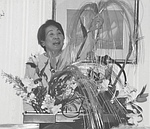Judy Hata: A Life Filled With Flowers
Judy Setsuko Hata and her husband Jack set down roots in Palisades before actually moving into their Dakota Street home. In 1956, after a drive to Congers to explore places to live, the newly engaged couple drove back along RT 303. Turning into Oak Tree, they were attracted to a model home for a new housing development, Palisades Gardens. They put a down payment on the last corner lot, then patiently waited a year to move in on September 1, 1957. Sixty-three years later she’s still here.
Judy raised her family here and quietly grew into a leader in Ikebana, the art of Japanese flow- er arrangement. Her children Bill and Jackie, graduates of Tappan Zee High School, went on to become engineers, Bill graduating from M.I.T. and Jackie from Princeton. In the 1970s, hardship befell the family when her husband Jack suffered a massive brain aneurysm. For fourteen years he was cared for at home until a broken hip necessitated his move to a nursing home, where he passed away in 1985. Judy is grateful for the support her family received from the Palisades Presbyterian Church, her neighbors and the Shapiros.
Judy graduated from the Shimer Great Books College in Illinois in 1954. Her early flower arranging training started in 1945 at the Ikenobo School in Fukuoka, Japan. In 1961 she became a student at the New York Segesu School, where she later served as director for 21 years.
The origins of the ancient art of Ikebana are in question; one theory is that it stems from the offering of flowers to the Buddha in the sixth century when Buddhism arrived in Japan. The quest of Ikebana is to bring out the inner qualities of blossoms, branches, leaves and stems, honoring and appreciating their seasonal importance while following a core set of arrangement principles. Her love of and talents in the art of Ikebana has made her a sought-after teacher, artist, mentor and presenter for over fifty years. She was an active board member for fifty-four years at Ikebana International, serving as its president for two terms. She has held teaching positions, most notably Parsons School of Design, Japan Society and the American Museum of Natural History. “Wasetsu” is Judy’s “flower” name.
Judy has had major solo exhibitions, demonstrations and large installations at the Metropolitan Museum of Art, Carnegie Hall, Bronx Botani- cal Orchid Show and the Horticultural Society of New York. Throughout the 1990s, she created installations for Hoya Crystal at Neiman Marcus, Saks Fifth Avenue and in Hoya shops in over 30 cities across the United States. She has also published a book, *Flowers are…East and West*.
Garnering countless accolades over her career, she received a commendation from the Japanese Consul General in 2014; in 2016 she was awarded the Sogetsu Sunlight Award, given to Sogetsu teachers who are 90 years or older for their long and significant career and, in 2017, she received the prestigious Order of Rising Sun Gold and Silver Rays, presented on behalf of the Emperor of Japan for outstanding contribution to Japan-US cultural relations through teaching Ikebana.
She’s constantly on the move, making morning runs into the Flower District to select flowers for her classes. She recently attended a Sogetsu seminar in Honolulu, an Ikebana conference in Dallas, taught in Pound Ridge and traveled to Longwood Gardens in Kennet Squire, Pennsylvania, where she was selected to create the over-sized arrangement in the entrance of the massive, daunting Blooms & Bamboo Exhibition: Chrysanthemum and Ikebana Sogetsu Artistry.
The Sunlight Award is particularly fitting because there is no indication that Judy, at 94, is even close to nearing her sunset.


